Indoor Air Quality Solutions
 INDOOR AIR IS 2 TO 5 TIMES MORE POLLUTED THAN OUTDOOR AIR
INDOOR AIR IS 2 TO 5 TIMES MORE POLLUTED THAN OUTDOOR AIR
Most of our exposure to environmental pollutants occurs by breathing the air indoors. These pollutants come from activities, products and materials we use every day. The air in our homes, schools and offices can be 2 to 5 times more polluted, and in some cases 100 times more polluted, than outdoor air.
PEOPLE SPEND 90 PERCENT OF THEIR TIME INDOORS
Indoor air quality is a significant concern, because when the hours spent sleeping, working in offices or at school are added up, people on average spend the vast majority of their time indoors where they are repeatedly exposed to indoor air pollutants. In fact, the US Environmental Protection Agency (USEPA) estimates that the average person receives 72 percent of their chemical exposure at home, which means the very places most people consider safest paradoxically exposes them to the greatest amounts of potentially hazardous pollutants.WHAT CONTRIBUTES TO POOR INDOOR AIR QUALITY?
CHEMICALS
The primary sources of indoor exposure to airborne chemicals are products used in interior environments, including furnishings, building materials and other household and office products.MOLD
Moisture problems are another common source of indoor air pollution as they can lead to indoor mold growth.PARTICULATES
The particles emitted from products such as furnishings, building materials and other household and office products are another source of indoor air pollution. Airborne particulates can also come from dirt and dust that is tracked in from outdoors. Particulates can trigger allergies and other respiratory problems in many people. Installing walk-off mats at doorways and changing air filters regularly are both good strategies to limit these pollutants.POOR VENTILATION
Most of the buildings in which people spend the majority of their time are tightly sealed and insulated to keep out unconditioned outdoor air. Furthermore, most ventilation systems are designed to bring in very little outdoor air and instead recirculate the indoor air that has already been heated or cooled. While this strategy is effective for minimizing energy costs, it can have a negative impact on indoor air quality. HOW OUR HVAC SYSTEM CAN HELP?
HOW OUR HVAC SYSTEM CAN HELP?
ADVANCED COMFORT SYSTEMS
We offers a full selection of high-performance heating and cooling systems that work to minimize up-and-down temperature changes, and keep Hot and Cold in check.HEALTHY CLIMATE® SOLUTIONS
From industry-leading air purification to high-efficiency filtration, HVAC Expert Service gives you a variety of innovative options for getting rid of bad air in your home and keeping your family safe.Call us today and our technicians will explain thoroughly all the options for a better and safer environment!
 Call Us 714-852-3742
Call Us 714-852-3742